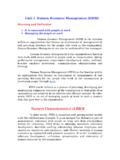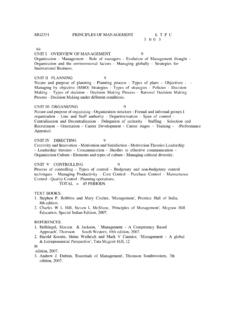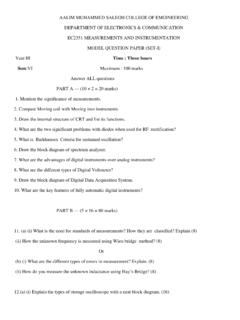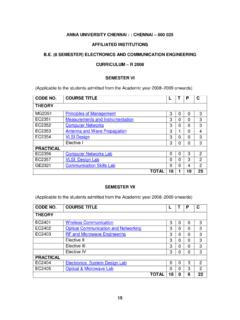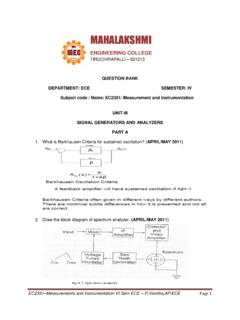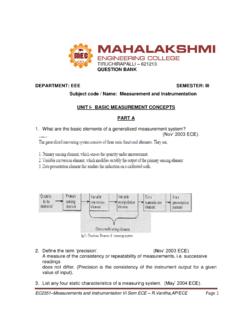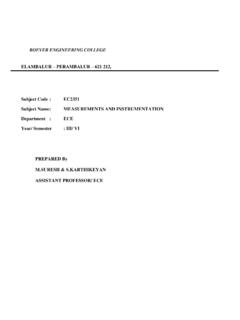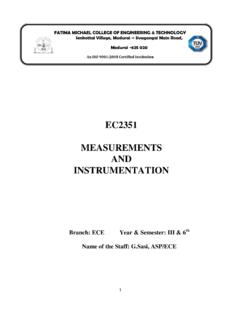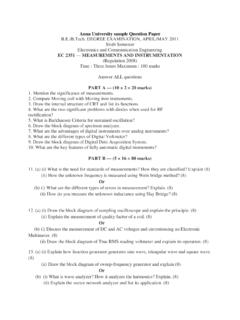Transcription of EC2351 MEASUREMENTS AND INSTRUMENTATION - …
1 AND INSTRUMENTATION DEPT/ YEAR/ SEM:ECE/ III/ VI MEASUREMENTS EC2351 SYLLABUS 3 0 0 3 UNIT I BASIC measurement CONCEPTS 9 measurement systems Static and dynamic characteristics Units and standards of MEASUREMENTS Error analysis Moving coil, moving iron meters Multimeters True RMS meters Bridge MEASUREMENTS Maxwell ,Hay ,Schering ,Anderson and Wien bridge. UNIT II BASIC ELECTRONIC MEASUREMENTS 9 Electronic multimeters Cathode ray oscilloscopes Block schematic Applications Special oscilloscopes Q meters Vector meters RF voltage and power MEASUREMENTS .
2 True RMS meters. UNIT III SIGNAL GENERATORS AND ANALYZERS 9 Function generators pulse and square wave generators, RF signal generators Sweep generators Frequency synthesizer Wave analyzer Harmonic distortion analyzer Spectrum analyzer - digital spectrum analyzer, Vector Network Analyzer Digital L,C,R MEASUREMENTS , Digital RLC meters. UNIT IV DIGITAL INSTRUMENTS 9 Comparison of analog and digital techniques Digital voltmeter Multimeters Frequency counters measurement of frequency and time interval Extension of frequency range Automation in digital instruments, Automatic polarity indication automatic ranging, automatic zeroing, fully automatic digital instruments, Computer controlled test systems, Virtual instruments . UNIT V DATA ACQUISITION SYSTEMS AND FIBER OPTIC MEASUREMENTS 9 Elements of a digital data acquisition system Interfacing of transducers Multiplexing data loggers - Computer controlled INSTRUMENTATION IEEE 488 bus Fiber optic MEASUREMENTS for power and system loss Optical time domains reflectometer.
3 Total = 45 PERIODS TEXT BOOK 1. Helfrick, and William Cooper, D., Modern Electronic INSTRUMENTATION and measurement Techniques , PHI, 2007. 2. Ernest O. Doebelin, measurement Systems- Application and Design , TMH, 2007. REFERENCES 1. Carr, , Elements of Electronics INSTRUMENTATION and measurement , Pearson education, 2003. 2. David A. Bell, Electronic INSTRUMENTATION and MEASUREMENTS , Prentice Hall of India Pvt Ltd, 2003. 3. Nakra and Choudhry, INSTRUMENTATION , measurement and Analysis, Edition , TMH, 2004. 4. James W. Dally, William F. Riley, Kenneth G. McConnell, INSTRUMENTATION for Engineering MEASUREMENTS , 2nd Edition, John Wiley, 2003. EC 2351 MEASUREMENTS AND INSTRUMENTATION L T P C 1 INTRODUCTION TO MEASUREMENTS AND INSTRUMENTATIONI nstrumentation is a technology of measurement which serves not onlyscience but all branches of engineering, medicine, and almost every humanendeavour.
4 The knowledge of any parameter depends on the is basically used to monitor a process or operation, or as well asthe controlling process. For example, thermometers, barometers are usedto indicate the environmental conditions. Similarly, water , gas and electricmeters are used to keep track of the quantity of the commodity used, andalso special monitoring equipments are used in on the nature of the application the selection of the instrumentmust be made intelligently and the use of it depends on a broad knowledgeof what is available and how the performance of the equipment renders itselffor the job to be major problem encountered in any measuring instrument is the it is obliviously necessary to select the appropriate measuring in-strument and measurement method which minimizes avoid errorsin any experimental work, careful planning, execution and evaluation of theexperiment are basic concern of any measurement is that the measuring instrumentshould not affect the quantity being measured.
5 Null MEASUREMENTS with theuse of feedback in an instrumental minimize these interference work employs a number of terms which should be :A device for determining the value or magnitude of a quan-tity or : Closeness with which an instrument reading approaches thetrue value of the variable being : A measure of the reproducibility of the MEASUREMENTS ; ,givena fixed value of a variable, precision is a measure of the degree to which suc-cessive MEASUREMENTS differ from :The ratio of output signal or response of the instrument toa change of input or measured : The smallest change in measured value to which the in-strument will : Deviation from the true value of the measured techniques may be used to minimize the effects of errors. Forexample, in making precision MEASUREMENTS , it is advisable to record a seriesof observations rather than relay on one observation.
6 Alternate methods ofmeasurement as well as the use of different instruments to perform the sameexperiment, provide a good technique for increasing 1 measurement Concepts andIndicating EquipmentsObjectives:Functional elements of an InstrumentApplications of measurement SystemStatic and Dynamic CharacteristicsStandardsCalibrationUnits and Units and standards of Units of measurementsTo specify and perform calculations with physical quantities,the physicalquantities must be define both in kind and standard measureof each kind of physical quantity is the unit;the number of time the unitoccurs in any given amount of the same quantity is the number of 1. measurement CONCEPTS AND INDICATING EQUIPMENTSFor example when we speak of a distance of 100 meters,we know thatmeter is the unit of length and that the number of units of length is physical quantity,length is therefore defined by the unit, the unit,the number of measure has no physical science and engineering,two kinds of units are used.
7 Fundamental unitsand derived fundamental units in mechanics are measures of length,mass and sizes of the fundamental units,whether foot or meter,poundor kilogram,second or hour are arbitrary and can be selected to fit a certainset of length, mass and time are fundamental to mostother physical quantities besides those in mechanics,they are called the pri-mary fundamental of certain physical quantities in the thermal,electrical an d illu-mination disciplines are also represented by fundamental unitsare used only when these particular classes are involved,and they may there-fore be defined as auxiliary fundamental units. All other units which can beexpressed in terms of the fundamental units are called derived unit originates from some physical law defining that derived unit is recognized by its dimensions,which can be defined as thecomplete algebraic formula for the derived dimensional symbols forthe fundamental units of length,mass and time are L,M and T and Magnetic unitsThe practical electric and magnetic units with which we are familiar,suchas volt,ampere, ohm,henry,etc.
8 ,were first derived in the CGS system of CGS electrostatic system is based on Coulomb s experimentally de-rived law for the force between two electric s law statesthatF=kQ1Q2r2( )whereF=force between the charges,expressed in CGSe units of force (g cm/s2=dyne)k=proportionality constantQ1,2=electric charges,expressedin (derived) CGSeunits of electric charge (statcoulomb) UNITS AND STANDARDS OF MEASUREMENTS5 QuantityUnitSymbolLengthmetermMasskilogr amkgTimesecondsElectric currentampereAThermodynamic temperaturekelvinKLuminous intensitycandelacdTable : Basic SI Quantites,Units,and Symbolsr=seperation between the charges,expressed in the fundamental CGSe unitof length (centimeter) Coulomb also found that the proportionality factor kdepended on the medium,varying inversly as its permitivitty .Coulombs lawthen takes the formF=Q1Q2 r2( )Since is a mumerical value depending only on the medium, a value of 1 wasassigned to the permittivity of free space, 0,there by defining 0as the fourthfundamental unit of the CGSe s law then alllowed the unitof electric charge Q to be determined in terms of these four fundamentalunits by the relation dyne=gcms2=Q2( 0=1)cm2and therefore dimensionally,Q=cm3/2g1/2s 1( )The CGSe unit of electric charge was given the name derived unit of electric charge in the CGse system if units allowed otherelectrical units to be determined by their defining exampleelectric current (symbol I) is defined as the rate of flow of electric charge andis expressed asI=Qt(statcoulomb/sec)( )6 CHAPTER 1.
9 measurement CONCEPTS AND INDICATING EQUIPMENTSThe basis of CGS electromagnetic system of units (CGSm) in coulomb sexperimentally determined law for the force between two magnetic poles,which states thatF=km1m2r2( )The proportionality factor k, was found to depend on the medium in whichthe poles were placed, varying inversly with the magnetic premeability ofthe factor k was assigned the value 1 for the permeability of freespace, 0, so that k=1 0= established the permeability of free space, 0,as the fourth fundamental unit of the CGSm derived electromag-netic unit of polestrength was then defined in terms of these four fundamentalunits by the relation dyne=gcms2=m2( 0=1)cm2and therefore dimensionally,m=cm3/2g1/2s 1( )The derived unit of magnetic polestrength in the CGSm system led tothe determination of other magnetic units, again by their defining flux density (symbol B), for example, is defined as the mag-netic force per unit pole strength, where both force and pole strength arederived units in the CGSm , B is found to be equal tocm 1/2g1/2s 1(dyne-second/abcoulomb-centimetre) and is given the , other magnetic units can be derived form defining equationsand we find that the unit for magnetic flux (symbol ) is given the namemaxwell;the unit for magnetic field strength (symbol H), the name orested.
10 And the unit for magnetic potential difference or magneto-motive force (sym-bol U), the name System of unitsThe international MKSA system of units was adopted in 1960 by EleventhGeneral Conference of Weights and Measures under the nameSysteme In-ternational d Unites(SI).The SI system is replacing all other systems in themetric countries and is widespread acceptance dooms other systems to even-tual six fundamental SI quantities are listed in Table derived unitsare expressed in terms of these six basic units by defining equations are givenin Table for the electric and magnetic UNITS AND STANDARDS OF MEASUREMENTS7 Quantity and symbolName and SymbolDefining equationCGSmCGSeElectric Current,Iampere AFz=10 7I2dNdz1010/cElectromotive force, Evolt V =IE10 810 8cPotential,Vvolt V =IV10 810 8cResistance,Rohm R=V/I10 910 9cElectric Charge ,Qcoulomb CQ=It1010/cCapacitance, Cfarad FC=Q/V109109c2 Electric field strength, E.
